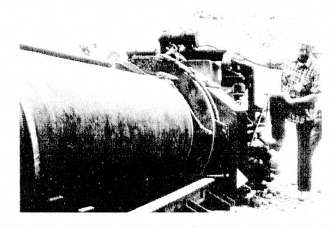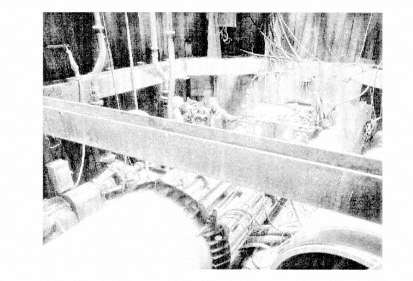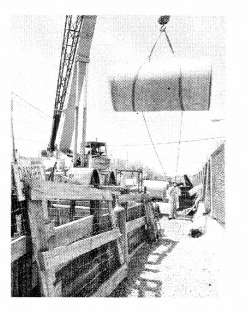7
SCIENCE OF MATERIALS PERFORMANCE AND DETERIORATION
The abilities of materials scientists and engineers to tailor materials from the atomic scale upwards to achieve desired functional properties have been increasing at rapid rates.1 The timespan between insight and application is shrinking, with the processes of discovery and development becoming increasingly more interactive.
Materials science and engineering are rooted in the classical disciplines of physics and chemistry. Investigations of structure and composition are focused on the electronic and atomic scales. At the stage of applications in infrastructure, the scale is large: elevated rail and highway structures, long-span bridges, long or large diameter pipelines. Infrastructure material science and engineering must span this range of scales, moving from the clean rooms and other specialized environments of the laboratory to the dirty and highly variable conditions of construction and infrastructure-in-use.
A major challenge of infrastructure research is to promote a productive interaction among material scientists and practicing engineers so that fundamental advances through new material developments can be effectively integrated into practice, yielding more durable and reliable structures and system components. Research activities should enhance communication between scientists and engineers, and stimulate interaction between basic and applied research.
Materials for construction, protection, maintenance, and repair of facilities are basic to all infrastructure. Materials such as Portland cement, steel, and asphalt are used widely and in large volumes. Epoxy resins, glass fibers, aluminum and thermoplastic polymers, and other substances have
been less widely used. Nevertheless, because of the scale of the U.S. infrastructure, more effective use of all these materials presents significant opportunities for improved performance and cost savings.
Many infrastructure components experience progressive damage that eventually necessitates major repair or replacement. Micro-cracking occurs in concrete pavements, tunnel linings, bridge structures, and pipes, while fatigue in metals and polymeric materials reduces their reliability. Sometimes this damage proceeds more rapidly than anticipated, due to unexpected usage, severe environmental conditions, or statistical extremes in material variability. Payoffs of infrastructure-oriented research in the science of materials performance and deterioration could include enhanced strength, durability, ease of manufacture and construction, as well as reduced costs and environmental and safety hazards. Two research areas that offer high payoff potential are discussed in this chapter:
-
development or adaptation of high-performance materials for infrastructure; and
-
improved analysis methods for characterizing damage, deterioration, and aging in infrastructures.
HIGH-PERFORMANCE MATERIALS
Because of economic constraints, more cost-effective utilization of existing infrastructure, such as nuclear power plants, roads, bridges, and pipelines, is imperative. In addition, new infrastructure often must be constructed adjacent to or beneath existing facilities that severely limit available space and allowable deformation of structures and soils. Such construction increasingly depends on new and unorthodox materials and composites—for example, high-alloy steels, glass-fiber-reinforced resins and concrete and polymers—that offer high strength, low weight, and durability, that were, until recently, available only in aerospace, weapons, and other high-technology applications.
Polymers
Polymers display a wide range of properties, which make them highly adaptable to the variable conditions and uses that characterize infrastructure. Many polymers have mechanical attributes in the form of high strength, high flexibility, and lightweight. Electrical, thermal, and optical properties make certain classes of polymers especially well suited for specialized applications. The rapid growth and widespread use of high- and medium-density polyethylene (HDPE and MDPE) and polyvinylchloride (PVC) in underground piping networks attest to the importance of such
materials. Over 90 percent of all gas distribution piping placed today is composed of polyethylene. Applications on this scale illustrate how effective polymers have proven as substitutes for metals in portions of the infrastructure that once were dominated by steel, cast iron, and copper. Indeed, as reported in a previous study (NRC, 1989c), structural polymers are already in widespread use and account for a major portion of the $100 billion global market for polymers.
Polymers also have been put to good use in infrastructure systems to control water and gas leakage, provide protective coatings, and improve the performance of bearings. Both PVC and HDPE membranes have been applied extensively to restrict water leakage in landfills and tunnel linings. Polyurethanes and epoxies are applied as sealants and protective coatings to a wide range of above-ground and subsurface structures. Methacrylates are used to seal gas piping under anaerobic conditions. Composite polymers are incorporated in the bearing systems of bridge decks and in seismic base-isolation components for building protection.
Typical questions for research might include the following examples:
-
What are the characteristics of conductive polymers? How can such materials be used as protective coatings, leakage membranes, and water barriers, which will have the ability to sense and locate imperfections and breaches leading to leakage or exposure?
-
How can the strength, load/deflection characteristics, and durability of structural polymers be improved for more frequent application in infrastructure systems? What are the properties of such materials, and how can these properties be specified and used most effectively in design?
-
What are the most effective test procedures for accelerated aging of polymeric materials, and how can the associated test results be applied in design?
Geosynthetics
Geosynthetics comprise a class of substances that has evolved rapidly over the last decade, primarily for use in association with soil and rock. The materials have played an increasingly important role in promoting secure landfills, stabilizing roadbeds and embankment foundations, reinforcing slopes, and strengthening waste retention systems. They are used with virtually all forms of drainage control, road construction, landfills, and reinforced soil systems. Their importance with respect to infrastructure derives primarily from their integration with soils to improve the performance of foundations, soil structures, and in-ground drainage and retention systems. Geosynthetic materials perform several major functions, such as separation of different grain sizes, reinforcement of soil, filtration and drainage in subsurface fluid control, groundwater control, and
as barriers to fluid movement in and around underground structures. Geosynthetics may be manufactured as textiles or fabrics, grids, nets, and membranes, and are composed of polymers, rubbers, fiberglass, and other material constituents.
Typical questions for research might include the following examples:
-
What stress relaxation behavior can be expected from different geosynthetics and how can it be characterized for analysis and design?
-
What are the failure mechanisms of geosynthetics in earth retention systems and reinforced slopes? How can small- and large-scale experiments be directed most effectively to clarify the fundamental nature of failure and soil-structure interaction of geosynthetically reinforced walls and slopes?
-
Are there effective ways of in situ spraying or spreading geosynthetic materials, and what are the durability and other performance characteristics of materials thus applied?
-
What are the tolerable levels of deformation and disturbance associated with geosynthetic membranes, reinforcing systems, and composites of two or more geosynthetic products?
Other High-Performance Material Applications
Opportunities for high-performance materials in infrastructure extend well beyond structural applications, warranting research on a very broad range of questions. High operating-temperature superconductors could improve electric-power transmission efficiencies and possibly enable development of effective magnetic-levitation transport systems. New optical-fiber materials might enable power transmission and improved resistance to adverse operating environments. New patching and fill materials could improve pavement maintenance efficiency. Fiber-rein-forced polymer-based composite materials with high strength-to-weight ratios and corrosion resistance could replace conventional materials in bridges and increase the bridges' load-bearing capacities. Chemical or biological additives could give concrete, earth, and rockfill structures (e.g., dikes and embankments) abilities to "heal" when damaged by seismic or other unusual loads. Coatings could signal when strain or damage to structural elements has progressed to levels warranting maintenance.
CHARACTERIZATION OF DAMAGE, DETERIORATION, AND AGING
Those responsible for infrastructure design and management need mathematical models and other analytical tools to select facility design characteristics, and operating and maintenance strategies to ensure cost-

PIPE JACKING BENEATH RAILWAY

PIPELINE CROSSING OF HIGHWAY

COMPUTER GRAPHICS STRESS ANALYSIS OF PIPELINE CROSSING
PIPELINES CROSSING TRANSPORTATION ARTERIES
High-pressure gas and liquid fuel pipeline crossings of highways and railroads have been viewed as inherently hazardous, and significant interest in this issue has been expressed by the gas, petroleum, highway, and railroad industries. Research supported by the Gas Research Institute at Cornell University was undertaken to perform three-dimensional stress and deformation analyses of pipeline crossings, field test instrumented high-pressure pipelines beneath heavily loaded railway facilities, and develop standards for pipeline crossing design and installation practice. The development of new procedures and technology acceptable to many different industries required an intensely coordinated effort. The research has resulted in a new design methodology adopted by the gas industry, and embodied in the standards promulgated by the American Railway Engineering Association and the American Petroleum Institute. Research could support development of new standards as well as immediate improvements in infrastructure performance.
effective performance. These analytical procedures must accommodate material behavior such as crack propagation, visco-elastic and plastic response to loads, dilation, and other nonlinear elastic behavior. Such mechanisms depend on loading, temperature, and other environmental conditions. In pavements, pipes, and large building or bridge structures, discontinuities at joints and in foundation materials must be considered.
Improved constitutive relationships for analysis procedures, as well as better defined damage and failure criteria, will permit the more effective utilization of the various materials in infrastructure. This in turn will significantly extend the life and reduce costs associated with damage caused by increasing traffic volume and loads on pavements. The same is true for assessment of existing structures such as buildings and bridges in seismically active areas.
Limit States And Failure Criteria
Better understanding is needed of the mechanisms and conditions that lead to failure of materials in infrastructures. Crack initiation and propagation in conventional materials, such as asphalt and Portland cement concrete, as well as newer plastics and composites, are difficult to observe, model, and predict. Reliable failure criteria could be developed, using stress/strain invariants, for composite materials subjected to multi-axial stress over a wide range of temperatures and loading frequencies (e.g., nuclear-waste containment facilities, fuel tanks, pipelines in environmentally sensitive sites).
Time-Dependent Deformation And Strength
Better understanding is also needed of the long-term behavior of materials that exhibit nonlinear elastic, visco-elastic, and plastic response to loading, such as asphalt concrete, plastics, and other polymeric materials. The effects of temperature and aging on these and more traditional civil engineering materials (e.g., steel and Portland cement concrete) are complex and have yet to be well represented by analytical models.
Typical questions for research might include the following examples:
-
Can computational algorithms be developed to enable more effective three-dimensional finite-element idealizations to be used in the analysis and design of infrastructure components (e.g., representing dynamic response of concrete pavements including the effects of discontinuities such as joints and voids, and permanent deformations in asphalt-concrete pavements)?
-
Can reliable models be developed for analysis of corrosion fatigue in bridge structures and underground steel and cast-iron pipes?
Cost-Effectiveness Assessment
Materials used in infrastructure must perform over long periods of time. Development of new materials is hampered by the need to simulate long-term service conditions or to collect and analyze data over long periods. Research to find cost-effective methods for materials performance testing could yield substantial payoffs.2
A particularly difficult set of questions has to do with materials that use waste products (residuals) from other infrastructure activities. Sewage sludge and fly ash (produced by burning coal for electric-power generation), in particular, can contain heavy metals or other constituents that may eventually leach out to contaminate water supplies or otherwise pose environmental and health hazards. Research could yield better methods for assuring long-term stability of waste-incorporating construction materials.
Typical questions for research might include the following examples:
-
Can expert-systems software be developed for infrastructure materials evaluation (e.g., categorizing weld quality and inspection data for bridges and power-plant systems)?
-
Can rapid-proofing methods be developed for determining stability and other performance characteristics of materials incorporating waste products (e.g., sewage sludge and fly ash)?
NOTES
|
1 |
For further discussions of developments in materials sciences, see for example, Materials Science and Engineering in the 1990s, Maintaining Competitiveness in the Age of Materials, published in 1989 by the National Academy Press. |
|
2 |
Research in this topic area is related to condition assessment and long-term monitoring (Chapter 6) intended to support infrastructure management. |


JACKED SEWER PIPE ON STATEN ISLAND, NEW YORK
The Oakwood Beach collector included 7,000 feet of 63" O.D. lacked pipe made of a new combination of woven fiber-glass, polyester resin and silica sand. This is a Swiss innovation, manufactured by a computer-controlled spinning process. It offers high yield strength, 12 to 16 ksi, lightweight, easy handling, low friction to facilitate jacking and increased hydraulic capacity. At an 85-foot depth, the jacking rate reached 122 feet in a 12-hour shift, using a mole with crunching ability to handle the glacial soil. Such examples illustrate the value of answering such research questions as these: How can the strength, load/deflection characteristics and durability of structural polymers be improved far more frequent application in infrastructure systems? What are the properties of such materials, and how can these properties be specified and used most effectively in design?








